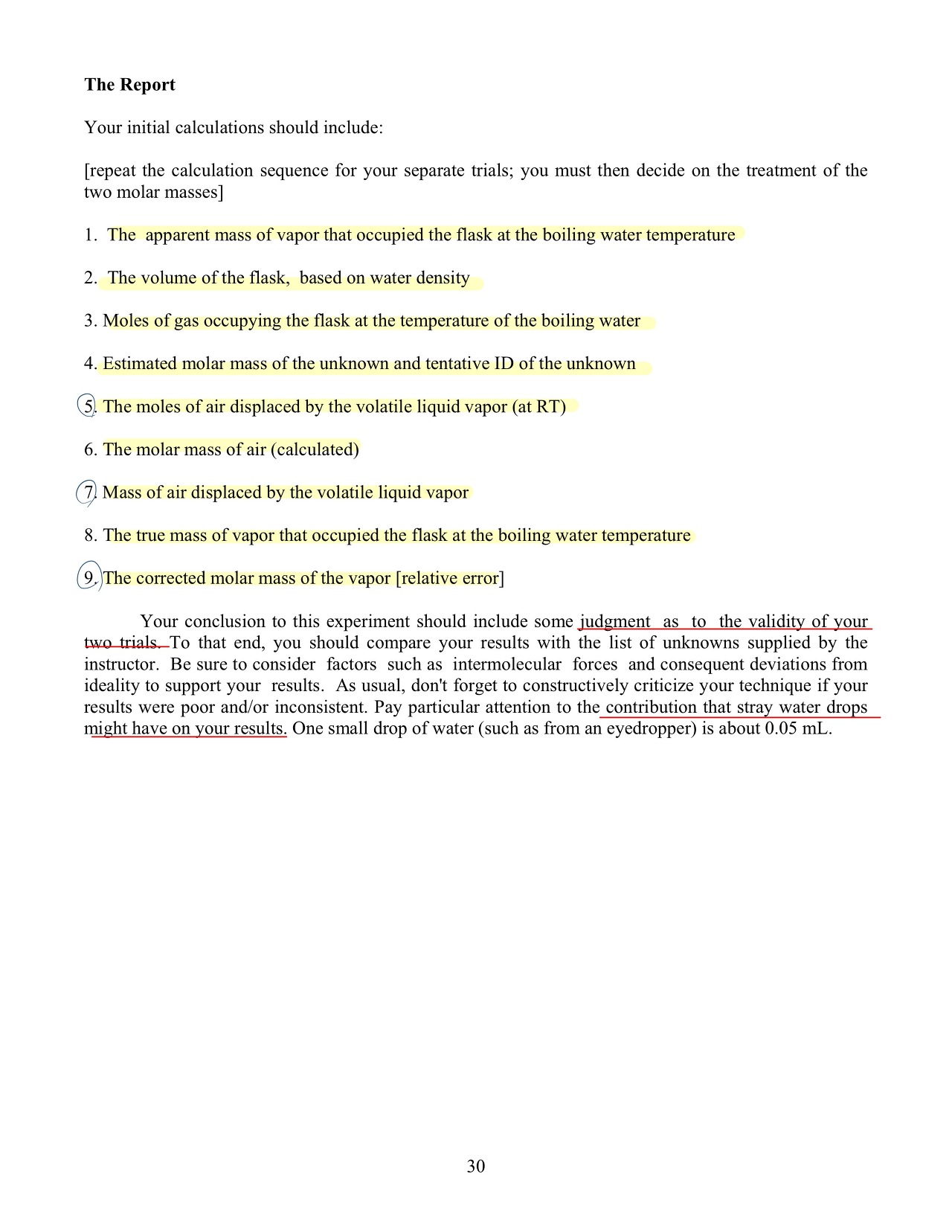만점 레포트
다른 레포트들은 완전 아쉽게 이름 미작성 감점 등
자잘한 부분들이 있었는데(내용상 감점은 크게 없었음)
요번 레포트는 만점 받았습니다
▼ Exp2. 재결정과 거르기 보러가기 ▼
일반화학실험#2 재결정과 거르기(Recrystallization and filtration) 보고서(리포트), 내용총정리
▼ Exp1. 유리세공 보러가기 ▼ 일반화학실험#1 유리세공 (Glass Blowing and Capillary) 보고서(레포트), 내용총정리 Exp1. Glass Blowing and Capillary (유리세공) 🧪 일반화학실험 1번째 포스팅 ✔ 대학..
young-brightening.tistory.com
Exp4. Molar Mass Determination (몰질량 측정)
🧪 일반화학실험 3번째 포스팅
✔ 대학교 수업자료는 영어로 제공되기
때문에 영어내용이 포함되어 있습니다.
영어내용은 한국어로도 적어둘게요
(순서: 영어 - 한국어)
한국어로 번역이 안 되어 있는 내용은
파파고에 복사붙여넣기 하시면
내용을 쉽게 읽으실 수 있어요 ˘◡˘

✔ 많은 고등학생/대학생 분들께
실험 내용을 알려드리기 위해
작성한 포스팅입니다.
표절을 하게 되면 유사도검사를
통해 불이익을 받을 수 있습니다.
참고 교재


General Chemistry Laboratory 7th Edition
(표준 일반화학실험 제7개정판)
저자 대한화학회
출판 천문각
1. 실험목적
이상기체 상태 방정식을 이용해서 쉽게 증발하는 기체의 몰질량을 결정한다.
2. 실험원리 / 이론적배경
원자나 분자는 매우 작은 입자이기 때문에 질량을 직접 측정하는 것은 매우 어려워요 '~'
그래서!! 원자나 분자의 질량을 나타내기 위해서 상대적인 방법을 사용하죠,
여기서 많이 들어보셨을 "몰" 개념이 등장한답니다 ..!
사실 화학1 내용이라 웬만한 고등학생이나 성인분들은 다 알 만한 개념이지만,
정확한 정의를 알려드리도록 하겠습니다.
- 몰질량(Molar mass): 1몰에 해당하는 분자의 질량
- 1몰 (mole, 줄여서 mol이라고도 함): 탄소의 질량수 12인 동위원소 12C(탄소12)의 12g에 포함되는 원자 수
- =아보가드로 수: 6.022 X 10^23
(탄소의 질량수 12인 동위원소 12C의 12g에 포함되는 원자수 =아보가드로 수)

대부분의 기체는 상온, 상압에서 이상기체 상태 방정식을 어느 정도
만족하기 때문에 기체의 부피(V), 온도(T 절대온도여야 함), 압력(P)과
함께 용기를 가득 채우는 데에 필요한 물질의 질량(W)을 측정하면
이상기체 상태 방정식으로부터 몰질량(M)을 계산할 수 있다
- 이상기체 상태 방정식: PV=NRT, 단 n=W/M
- P: 대기압 (1atm)
- V: 플라스크 부피
- n: 몰수
- R: 기체상수, 0.082 atm*L/mol*K
- T: 기체가 기화되는 온도, 다시 한 번 적지만 절대온도 K임
교과서 내용
(제가 필기한 내용이나 하이라이트 친 부분들 위주로 보면 공부하기 더 좋으실 거에요..!)





밑에 실험결과까지 있따구..
영어나온다고 다들 떠나가지마악ㄱ악
3. 준비물 :실험기구 및 시약
<실험기구>
- 비커
- 둥근바닥플라스크, 삼각플라스크
- 피펫
- 바늘
- 온도계
- 가열기
- 스탠드
- 클램프
- 링
- 삼각대
- 화학저울
- 알루미늄박
- 눈금실린더
- 면장갑
- 쇠그물망
<시약>
- CH3COOCH(CH3)2 (isopropyl acetate)
- (CO3)2CHOH (2-propanol, isopropyl alcohol)
- CH3CHHC2H5 (ethyl acetate)
- 위 3개 시료 중 하나 또는 둘을 골라서 사용
4. 실험방법
① 액체를 가열해서 일정한 부피를 가진 플라스크의 내부를 기체로 채우고,
플라스크를 다시 냉각시켜 액체로 만든 후 질량을 측정하는 방법을 사용
② 질량과 가열 중의 온도, 대기압, 플라스크의 부피를 구하고
이상기체 상태 방정식 (PV=nRT)을 이용해 몰질량을 계산한다
5. 실험결과
report (를 가장한....문제 폭탄)

(교수님..그리고 조교님 한 학기 내내 화학 문제만 500개 넘게 푼 것 같지 뭡니까^^;;)

그럼 가보자고
5-1. Based on the results in the table below, calculate the molar mass
for the unspecified substance 1, 2, and 3.
(gas constant: 0.082 atm∙L /mol∙K, 0℃ = 273K)
(Write down the process of calculation. Write the molar mass to the second decimal place.) (12 points)
answer of 5-1)
| unspecified 1 | unspecified 2 | unspecified 3 | |
| The weight of flask + cork ring + 2 aluminium foils before the evaporation |
90.127 g | 82.193 g | 74.816 g |
| The weight of flask + cork ring + 2 aluminium foils after the evaporation |
90.557 g | 82.603 g | 75.118 g |
| The weight of condensed reagent | 0.43 g | 0.41 g | 0.302 g |
| The boiling point | 89℃ (362K) | 78℃ (351K) | 81℃ (354K) |
| Atmospheric pressure | 1 atm | 1 atm | 1 atm |
| The volume of the flask | 120 mL | 131 mL | 132mL |
| The molar mass of the liquid reagent | 106.37g/mol | 90.08g/mol | 66.41g/mol |
5-2. Referring to the table below, please guess what
the unspecified substance 1, 2, and 3 are. (6 points)
| Chemical | Molecular structure | Molecular weight (g/mol) |
| isopropyl acetate | 102.13 | |
| ethyl acetate | 88.11 | |
| 2-propanol | 60.10 |
1- isopropyl acetate
2- ethyl acetate
3- 2-propanol
5-2-1. Calculate the percent error of the molar mass
that you got in Q1.1. for the actual molecular weight of each
substance. (Write down the process of calculation) (6 points)
% Error= Theoretical value-Experimental value Theoretical value×100
answer of 5-2-1)
<1>(l102.13-106.37l/102.13)x100= (4.24/102.13)x100=(0.04151572)x100=4.151572% -> 4.15% (유효숫자처리)
<2>(l88.11-90.08l/88.11)x100=(1.97/88.11)x100=(0.02235842)x100=2.235842% ->2.24%
<3>(l60.10-66.41l/60.10)x100=(6.31/60.10)x100=(0.10499168)x100=10.499168% ->10.50%
5-2-2. Describe any factors that may affect the percent error. (6 points)
answer of 5-2-2)
- The vapor is assumed to behave ideally at the temperature and pressure at which it occupies the container. The amount of error implicit in this approximation varies from compound to compound and is tied to the variables which create deviations from ideal behavior: molecular volume and intermolecular forces.
- And when the container is massed again there is air missing that should be counted in the final mass if the mass of liquid that is too small which in turn makes the molar mass calculation too small.
- If you do not use a clean, dry 125mL Erlenmeyer flask(this flask is enough to mass on the analytical balance and large enough to contain a sufficient mass of vapor.), it may affect the percent error. (The flask also can be changed to the thing that satisfies upper condition.)
- Excess foil should be removed with a razor blade as it provides a place for condensed water to hide. Once prepared it should be massed “empty”, or it can cause the percent error.
- When we makes a tiny hole in a foil cap and 3-4mL of the liquid is injected, enlarging the hole at this point with an unsteady hand will introduce serious errors into the determination.
- The flask should be immersed in a 600 mL beaker of water (with a few boiling stones added), or the percent error can be caused.
- The water bath should be brought quickly to a boil but then the heat should be reduced to achieve a gentle boil for about 10 minutes or until all of the liquid is evaporated. Without this process, the percent error can be caused.
- Not to cause the percent error, water must be removed completely from the outside of the flask. (Be especially careful about the cap edges as steam from the boiling water can condense just under the edges and change the mass of the container significantly.)
- 실험에서 물질을 증발시킬 때 기체가 플라스크 내벽에 응축되거나 물질에 기화되지 않은 불순물이 남아있으면 양의 오차가 발생하고 무게가 증가하여 몰질량이 더 측정될 것이라고 생각한다.
- 플라스크 겉면의 물을 제대로 닦지 않아도 오차가 발생할 것이라고 생각한다.
6. 주의 및 참고사항
- 증발한 기체를 직접 흡입하지 않도록 조심하고, 실험실의 환기가 잘 되도록 하기
- 가열된 플라스크 등에 화장 입지 않게 주의
- 오차율 계산 공식 똑바로 쓰기
- 위 5-2-2 answer에 따라 오차가 발생하지 않도록 유의하기 ★☆
7. 레포트 자료 구매 안내
해피캠퍼스 플랫폼을 통해 유료로 화학실험 레포트들을 구매하실 수 있습니다
(아래 링크를 통해 둘러보실 수 있어요)
완충용액 (Buffer Solution)
일반화학실험2 완충용액 레포트 레포트
A. Objectives 완충 용액의 원리를 탄산같은 이양성자산의 적정 곡선을 통하여 배운다. 실험에서는 염산 수용액으로 탄산염 수용액을 적정하면서 탄산이온이 모두 소모되는 제1 종말점과 중탄산이
www.happycampus.com

평형상수와 용해도곱 결정
일반화학실험2 평형상수와 용해도곱 결정 레포트 레포트
A. Objectives 색깔을 비교하는 방법(비색법)을 이용해 착이온의 농도를 알아내어 착이온 생성 반응의 평형상수를 결정하고, 포화 용액에 공통이온 효과를 이용해서 용해도곱을
www.happycampus.com
촉매반응
일반화학실험2 촉매반응 레포트 레포트
A. Objectives 과산화수소의 분해 반응을 빠르게 하는 다양한 촉매와 반응을 느리게 하는 억제제의 작용과 그 원리를 알아본다. 화학 반응의 속도를 변화시키는 촉매의 원리를 이해한다. B. Principles
www.happycampus.com
전기분해와 전기도금
일반화학실험2 전기분해와 전기도금 레포트 레포트
A. Objectives 전기 에너지를 이용해서 일어나는 화학 반응에 대하여 알아본다. 전기 분해, 전기 도금, 패러데이의 법칙에 대해 이해한다. B. Principles & Methods 전기분해란 전극을 통해서 전원에서 공
www.happycampus.com
의약품합성-아스피린
일반화학실험2 의약품합성-아스피린 레포트 레포트
A. Objectives 가장 성공적인 의약품의 하나인 아스피린을 합성하여 유기 합성의 의미를 배운다. B. Principles & Methods 유기합성이란 탄소 화합물을 중심으로 하는 유기 화합물의 인공적 합성이다. 탄
www.happycampus.com
시계반응
일반화학실험2 시계반응 레포트 레포트
A. Objectives 시계 반응을 이용해서 반응 속도의 차이가 큰 반응 단계가 연속적으로 일어나는 화학 반응의 특성을 알아본다. B. Principles & Methods 지금까지 개발된 시계 반응에는 여러 종류가 있는데,
www.happycampus.com
🧪 이외에도 많은 일반화학실험 글들은 Category [대학생활-대학공부] 참고
▼ Exp5. 탄산염 분석 보러가기 ▼
일반화학실험#5 탄산염 분석(Analysis of Carbonate Salt) 보고서(레포트), 내용총정리
▼Exp4. 몰질량 측정 보러가기▼ 2021.07.26 - [입시 (학종, 생기부)/환경] - 일반화학실험#4 몰질량 측정(Molar Mass Determination) 만점보고서(레포트), 내용총정리 일반화학실험#4: 몰질량 측정(Molar mass de..
young-brightening.tistory.com
이 글의 저작권은 필자에게 있으며,
허가 없이 일부만을 발췌하더라도
법적인 제재를 받을 수 있음을 밝힙니다.
Copyright ⓒ 2022 All rights reserved by @young_claudialee.
All pictures and contents cannot be copied without permission.
'대학생활 > 대학공부' 카테고리의 다른 글
| Global Land Outlook Report(UNCCD 유엔 사막화 방지 협약) 보고서 요약정리 (2) | 2023.12.22 |
|---|---|
| 공학설계 특별수업(3D Modeling, 가새골조 의자만들기, 은박지 소품제작) (4) | 2022.07.31 |
| 일반화학실험 #8 이산화탄소의 승화열(Sublimation Heat of CO2) 보고서(리포트), 내용총정리 (8) | 2022.05.22 |
| 일반화학실험#5 탄산염 분석(Analysis of Carbonate Salt) 보고서(레포트), 내용총정리 (8) | 2022.03.30 |
| 만점레포트:두교황 영화감상문 (기독교와세계) (27) | 2021.12.24 |
| [고급영어]만점받은 영어에세이 예시-아카데믹라이팅, contrast essay:The Differences between Plastics and Bioplastics (31) | 2021.12.16 |
| 일반화학실험#2 재결정과 거르기(Recrystallization and filtration) 보고서(리포트), 내용총정리 (10) | 2021.05.25 |
| 일반화학실험#1 유리세공 (Glass Blowing and Capillary) 보고서(레포트), 내용총정리 (7) | 2021.05.18 |



